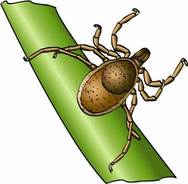Natural Tick PreventionKeep yourself healthy and safe during tick season. Use non-toxic alternatives to avoid tick contact.
|
|
In all things of nature there is something
of the marvelous. —Aristotle |
10 Tips to Prevent Tick Bites

Ticks are not nice. I’m a big fan of nature, but ticks are just unpleasant. They show up just when the weather is starting to get warm and we want to be outside. We encounter ticks when gardening, doing yardwork, or hiking. Don’t you hate that tell-tale feeling of something crawling under your sleeve?
Tick bites can potentially infect humans with bacteria, viruses, or parasites. Lyme disease is a serious illness. Don’t let the dread of tick season keep you from the outdoors. Try out some of these ideas below. 10. Learn Where to Expect Ticks
The best way to prevent ticks is to avoid tick encounters. Know and understand tick environments. Ticks are most likely to be found:
9. Dress Defensively
When you must go into areas with ticks, dress appropriately. Wear long pants and long sleeves, even on hot days. Ticks climb up, so tuck your pants into your socks, and your shirt into your pants. Wear beige, white, or light colored clothes so that you can see any ticks crawling on you before they reach skin areas. Wear a light colored, rimmed hat and avoid low tree branches. 8. Spray a Tick Repellent
As much as you may not like the smell, do use a tick repellent on clothing and on skin. There are natural tick repellents that you can purchase or make at home. Essential oils, vinegar, almond oils, and herbs can work to deter ticks and are safe on skin—humans and pets. Read more about Safe, Natural Tick Repellents. If you choose a commercially prepared tick repellent be aware of the ingredients, especially DEET or pyrethemin. These work really well, but are toxic and/or irritants. If you must, use only on clothing, not on skin. 7. Carry Sticky Tape
Ticks are tiny. When they are crawling on you, try using a piece of masking tape to lift and hold ticks until you can dispose of them. You could even carry one of the clothing lint sticky rolls to pick up any ticks crawling on your pants or shirt as you hike. 6. Shower Immediately
When you get inside from an outdoor activity, remove clothing on a bare floor, such as tiles in a bathroom. Then shower or bathe right away. Streams of water and soup suds should carry away most ticks that have not attached themselves, yet. Some ticks are too small to see and a shower is the best way to remove them before they bite and attach. 5. Use a Clothes Drier
Take your outdoor clothing that you have carefully removed and immediately wash all pieces, using a hot clothes drier. Simply washing them may not lose any ticks that are tight in seams or folds. A hot drier will do the trick. If you don’t have time to wash the clothes, just run all clothing, including underthings, in a hot, 30 minute spin in the drier. 4. Do a Thorough Check for Ticks
Checking for ticks should become a regular habit in the warm months. Do a full-body check with a full-length mirror AND a hand-held mirror. Start at the bottom and work your way up. Check over all parts of the body, especially:
3. Remove Attached Ticks
Not all ticks transmit diseases, and there is no need to panic if you find one attached. Remove it as soon as you find it. Work carefully with tweezers or a purchased tick removal tool. Gather at hand: fine-tipped tweezers, an alcohol swab, soap and water. Follow these steps:
2. Create a Tick-safe Lawn Zone
Clean-up landscaping around a home to create a “safe” zone that has few or no ticks.
1. Let Chickens Loose!
Ticks don’t have many natural predators in the wild. But it turns out that chickens like to eat them. If you have chickens, they can potentially eat as many as 10 ticks per hour. Ducks and ducklings, French Guinea hens, and other poultry eat ticks and other pesky insects, as well. Read more about Poultry Pest Control at Mother Earth News. Cluck, Cluck! |
|
|
Follow-up On Your Observations
If you do get a bite, track it for several days, and keep an eye on it for up to 30 days. Use a non-toxic marker to circle the area of the tick bite so that you know where to look. Look for:
If you liked this article about Natural Tick Repellents, you might enjoy reading Natural Tick Repellents and also Natural Remedies for Bee Stings. Read more Simple10s articles about Alternative Natural Medicine. |
CommentsBe the first to join the discussion! Add your Question or Comment HERE.
|
DISCLAIMER The content on SimpleTens is for educational purposes only and designed to support minor health issues, not to replace medical or psychiatric treatment. If you are concerned about a health issue, please see a health professional. Please read the full Disclaimer.



